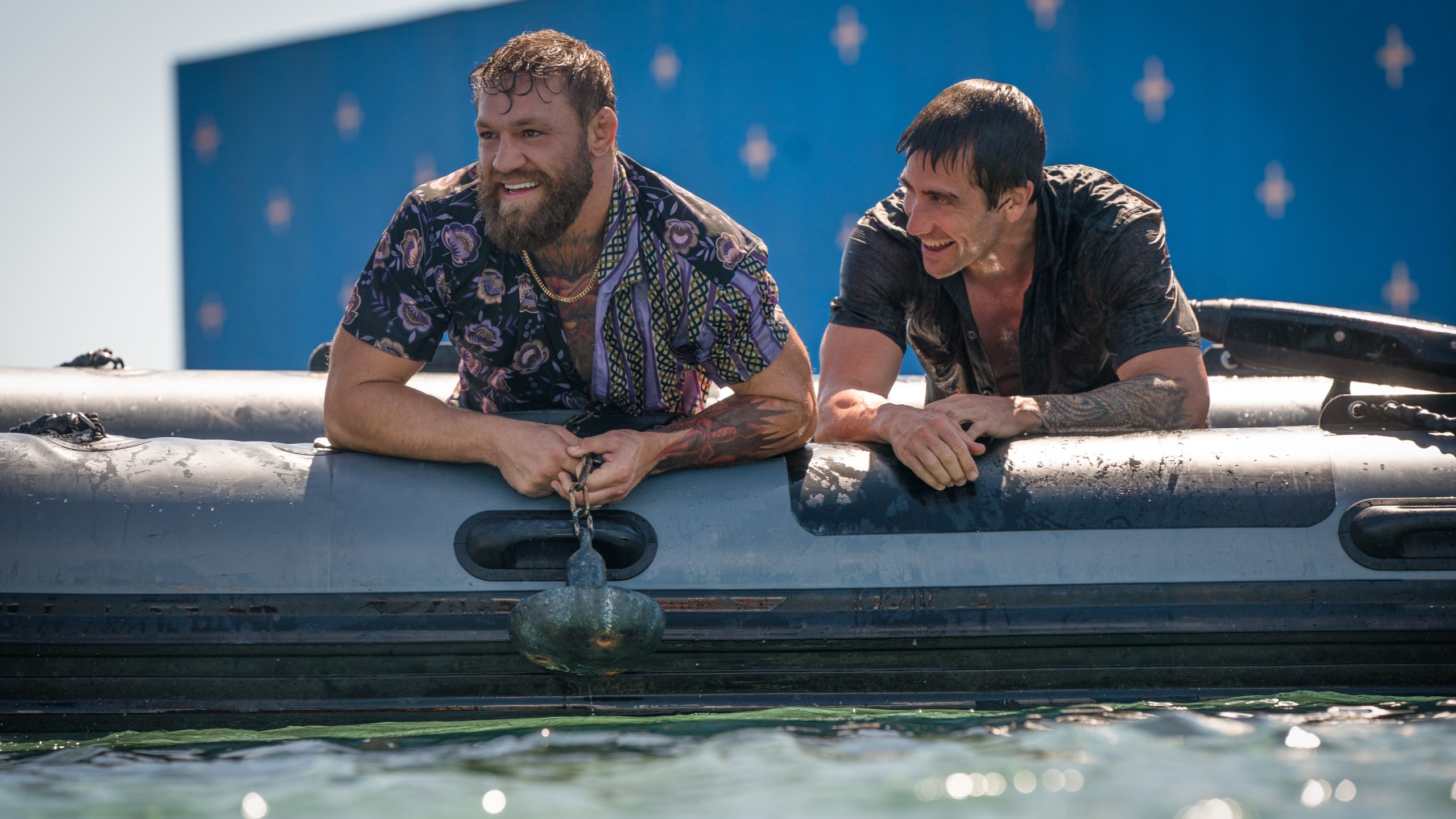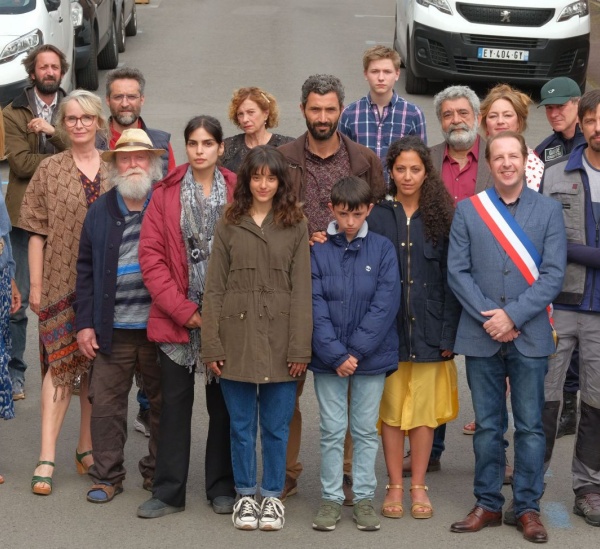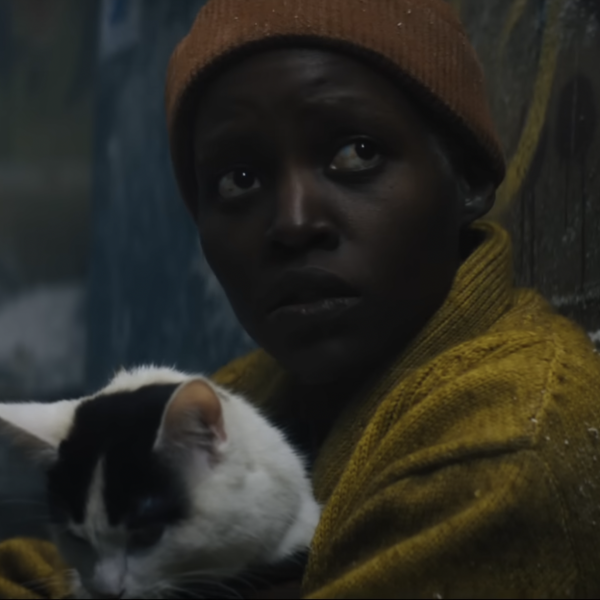There’s a moment in “Road House,” at a low point for Jake Gyllenhaal’s haunted ex-UFC fighter turned bouncer Dalton, where he’s been slapped around by crazed mob enforcer (Conor McGregor) and is ready to give up and leave. McGregor watches him go with a bloodthirsty grin (plus a lot of actual blood) on his face and says, “There’s something wrong with you. Me too.”
It’s a threat, a nod of respect, and a bit of a thesis for how the film’s action works. There’s something wrong (in the best way) with everyone in “Road House,” from the stars to the stunt team to director Doug Limon and cinematographer Henry Braham, who designed his own handheld gimbal that looks like a robotic arm and responds like a Steadicam’s stabilizers but is able to be thrown around a speedboat (presumably along with the camera operators).
Once Dalton is properly motivated to get back in the fight and take down McGregor and his nepo baby mob boss (a delightfully toady Billy Magnussen), a lot of the final action takes place on boats that crash, explode, nearly run over swimmers, and ultimately launch into the Road House itself. Obviously, there was a division of what could be accomplished practically at high speed, at a slower speed, with wires, and with the aid of visual effects. But the particular challenge that “Road House” took on was to build its water setpieces in longer shots, without atomizing the action and getting especially “cutty.”
According to fight coordinator Steve Brown, that’s only possible when the folks at the top of the call sheet are willing to not just memorize stunt choreography but put themselves physically and emotionally in the fight. Stunt coordinator Garrett Warren added that they were able to build ambitious setpieces because everyone was willing to get wet, be thrown around, and find the edge where the physical stunt work looks the most impressive.
“I don’t like watching movies where I’m never nervous,” Warren told IndieWire. A veteran of the water work and boat chases on the second of James Cameron’s “Avatar” films, Warren said that the key to great action was always being able to see its context and where the danger actually lies. “That was the thing that we wanted to make sure we always anchored ourselves to in the boat chase. We didn’t just want to be inside of two boats. We wanted to show people where the endpoint was and where the jeopardy was going to lie,” Warren said.
Finding the best place to point the camera is easier said than done. In the case of “Road House,” we can see boats careening towards one another, with rocks and an interstate bridge and a rather dangerous anchor all acting as trajectory-altering variables. “Your boat drivers are your absolute necessities. Just like on ‘Fast and Furious,’ you find wheelmen,” Warren said. “Those people are going to tell you what you can and can’t do safely, and then you can ask them, ‘How can we push the envelope?’”

Pushing the envelope, for Braham, meant a camera that keeps character action legible without going so wide that the audience starts to see them as action figures doing stuff that might look cool but doesn’t feel dangerous. “It’s a trap people can fall into where the action happens, and it’s like the camera is disconnected from it,” Braham told IndieWire. “So the idea is to put the camera in amongst the fight and to be very clear about the fight. You’re shooting it as a silent movie.”
Just because a sequence looks clear and simple doesn’t mean it isn’t assembled out of a bunch of painstakingly constructed layers. A boat collision between Magnussen’s getaway jetboat and an inflated motor boat, which sends Gyllenhaal flying onto the roof and then slams him down inside the villain’s vessel, was a stunt that Warren said took a lot of time to get his head around. It also took over two days to shoot.
One day was devoted to the lead-up to the crash, putting a drone behind a stunt performer and driving right at the larger, more solid vessel on the open water. “That was Eric Linden. My hat’s off to him. I’m telling you, he barely got away at the very end and almost kissed [the edge of the speedboat],” Warren said.
Next, the production built a ramp to simulate the collision and the flight of the inflatable boat. Inside a tank, the team had a cable pull it (so there’d be no carnage from the boat’s motor) at high speed. “We did the jump, which was to hit the ramp, jump off the boat, and go into the water. No boat coming at us, you know, visual effects would put it in,” Warren said.

After that, fight coordinator Steve Brown got on a set of wires and, at lower speeds, was pulled off the inflatable and onto the speedboat’s roof. On the same day, the team filmed him falling off the roof and hitting the back of the speedboat, this time at a higher speed. “That was basically two and a half days of filming to make that one shot work,” Warren said.
What was important for Brown (besides knowing how to take a massive hit) in the puzzle construction of the water stunts for “Road House” was to make sure the action was legible emotionally, as well as visually. It should escalate in terms of how much the hero has to endure, not in how many goons he takes out or the explosions he sets off. “When you see a fight scene, oftentimes we feel nothing,” Brown said. “So it’s not so much about what cool move you did or what punch you threw. It’s about why they threw it and what they’re fighting for.”
Brown worked with Gyllenhaal to layer the action with emotional highs and lows so that the trajectory of a sequence isn’t just about the main character being super amazing at fighting (although he is) but about continually exhibiting resilience and overcoming challenges. According to Brown, that collaboration improves the action and makes it easier for the actors to help make each shot of the stunt sequences longer, wider, and more involved.

“Jake did so much water stuff. So it was very easy for us to have these wide shots because we had Jake’s face, we had Jake’s performance, and he was very comfortable in the water. Everyone worked hand in hand, but you need the really good performers,” Brown said.
“I have such a big crush on ‘Road House,’ I can’t tell you,” Warren said. “Jake’s the one that came up with that stabbing section [in the film’s final fight]. He’s the one that came up with that slap section. He came up with it, and it really sold, and then you’ve got Conor McGregor who comes out there, and not only does he help Jake with the way he’s punching to look more vicious and more ferocious, but he’s also got these velvet gloves on going, ‘Don’t you worry, mate, I’ll take care of you.’”
That collaboration and mutual respect allowed the actors and the stunt team to build the kind of fights where characters are put on the back foot and need to claw their way to an advantage again, where there is this formidable give-and-take regardless of if the characters have golf clubs, or TNT, or a motor boat, or just their fists.
“Sometimes when you see people do a cool move or a big stunt, and then two seconds later, you see them running as if nothing ever happened. [That takes] the weight away from it. So we wanted to make sure that, as the fight’s progressing, they’re getting more tired. They should be a little bit more sloppy, and we want to feel that they’re digging deep to find a way to win,” Brown said. “We wanted to make sure that every hit mattered.”







